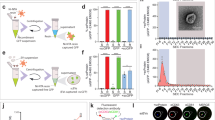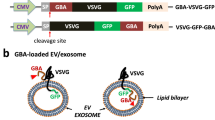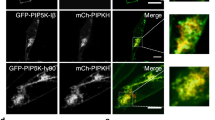Abstract
The effectiveness of viral vector-mediated gene transfer depends on the expression of therapeutic transgenes in the correct target cell types. So far, however, little attention has been given to targeted subcellular distribution of expressed transgenes. Targeting individual transgenes to particular subcellular compartments will provide various advantages in increasing the safety, efficacy, and specificity of viral vector-mediated gene delivery. Viruses normally hijack the cellular protein synthesis machinery for their own advantages. It is thus unknown whether cells infected with viral vectors will be able to target proteins to the correct subcellular organelles, or whether the subcellular targeting machinery would be selectively disrupted by viral infection. In this article we explored whether a herpes simplex virus type 1-derived vector could be used to deliver a transgene engineered to be targeted to the extracellular membrane of target cells. To do so we constructed a temperature-sensitive mutant HSV-1 vector, tsK-TT21 expressing a recombinant marker protein, tissue inhibitor of metalloproteinases (TIMP), linked to sequence encoding a signal for the addition of a glycosylphosphatidylinositol (GPI)-anchor within the endoplasmic reticulum. Our results demonstrate that HSV1-derived viral vectors can be used to target transgenes as GPI anchored proteins to the outside leaflet of plasma membranes, without disrupting the targeting machinery of host epithelial cells or neurons. This approach could then be used to target specific proteins to the cell membrane to modify cell–cell interactions, the function of specific plasma membrane proteins, or their interactions with other membrane proteins, and also to target a prodrug converting enzyme to the plasma membrane of target cells, therefore enhancing its cell killing effects.
This is a preview of subscription content, access via your institution
Access options
Subscribe to this journal
Receive 12 print issues and online access
$259.00 per year
only $21.58 per issue
Buy this article
- Purchase on Springer Link
- Instant access to full article PDF
Prices may be subject to local taxes which are calculated during checkout





Similar content being viewed by others
References
Marais R et al. A cell surface tethered enzyme improves efficiency in gene-directed enzyme prodrug therapy Nat Biotechnol 1997 15: 1373–1377
Dewey RA et al. Chronic brain inflammation and persistent herpes simplex virus 1 thymidine kinase expression in survivors of syngeneic glioma treated by adenovirus-mediated gene therapy: implications for clinical trials Nature Med 1999 5: 1256–1263
Cowsill CA et al. Central nervous system toxicity of two adenoviral vectors encoding variants of the herpes simplex virus type-1 thymidine kinase: reduced cytotoxicity of a truncated HSV1-TK Gene Therapy 2000 7: 679–685
Windeatt S et al. Adenovirus-mediated herpes simplex virus type-1 thymidine kinase gene therapy suppresses oestrogen-induced pituitary prolactinomas J Clin Endocrinol Metab 2000 85: 1296–1305
Vile RG, Sunassee K, Diaz RM . Strategies for achieving multiple layers of selectivity in gene therapy Mol Med Today 1998 4: 84–92
McHugh RS et al. Protein transfer of glycosyl-phosphatidylinositol-B7-1 into tumor cell membranes: a novel approach to tumor immunotherapy Cancer Res 1999 59: 2433–2437
Lowenstein PR et al. Use of recombinant vectors derived from Herpes Simplex Virus 1 mutant tsK for short term expression of transgenes encoding cytoplasmic and membrane anchored proteins in post-mitotic polarized cortical neurons and glial cells in vitro Neurosci 1994 60: 1059–1077
Lisanti MP et al. A glycophospholipid membrane anchor acts as an apical targeting signal in polarized epithelial cells J Cell Biol 1989 109: 2145–2156
Dotti CG, Parton RG, Simons K . Polarized sorting of glypiated proteins in hippocampal neurons Nature 1991 349: 158–161
Craig AM, Banker G . Neuronal polarity Annu Rev Neurosci 1994 17: 267–310
Jareb M, Banker G . The polarized sorting of membrane proteins expressed in cultured hippocampal neurons using viral vectors Neuron 1998 20: 855–867
Keller P, Simons K . Post-Golgi biosynthetic trafficking J Cell Sci 1997 110: 3001–3009
Ledesma MD et al. Maturation of the axonal plasma membrane requires upregulation of sphingomyelin synthesis and formation of protein–lipid complexes EMBO J 1999 18: 1761–1771
Stone D et al. Viral vectors for gene delivery and gene therapy within the endocrine system J Endocrinol 2000 164: 103–118
Easton RM et al. Analysis of events leading to neuronal death after infection with E1-deficient adenoviral vectors Mol Cell Neurosci 1998 11: 334–347
Lowenstein PR et al. Polarized distribution of the trans-Golgi network marker TGN38 during the in vitro development of neocortical neurons: effects of nocodazole and brefeldin A Eur J Neurosci 1994 6: 1453–1465
Lowenstein PR et al. Synaptogenesis and distribution of presynaptic axonal varicosities in low density primary cultures of neocortex: an immunocytochemical study utilizing synaptic vesicle-specific antibodies, and an electrophysiological examination utilizing whole cell recording J Neurocytol 1995 24: 301–317
Caplan MJ et al. Intracellular sorting and polarized cell surface delivery of (Na+, K+)ATPase, an endogenous component of MDCK cell basolateral plasma membranes Cell 1986 46: 623–631
Acknowledgements
This work was supported by project grants from The Wellcome Trust (UK) and BBSRC (UK) awarded to MGC and PRL. We also acknowledge the support that our unit receives from the MRC (UK), the Parkinson's Disease Society and EU Biomed Programmes (Contract No B104-CT98–0297, BMH4-CT98–3277 and QLK3-CT99–00364). We thank Professors AM Heagerty and F Creed for their support and encouragement, Mrs Ros Poulton for excellent secretarial assistance and Tricia Maleniak for her technical help. PRL is a fellow from the Lister Institute of Preventative Medicine. RLC is supported by a BBSRC/CASE studentship.
Author information
Authors and Affiliations
Rights and permissions
About this article
Cite this article
Brown, O., Cowen, R., Preston, C. et al. Subcellular post-transcriptional targeting: delivery of an intracellular protein to the extracellular leaflet of the plasma membrane using a glycosyl-phosphatidyl inositol (GPI) membrane anchor in neurons and polarised epithelial cells. Gene Ther 7, 1947–1953 (2000). https://doi.org/10.1038/sj.gt.3301325
Received:
Accepted:
Published:
Issue Date:
DOI: https://doi.org/10.1038/sj.gt.3301325
Keywords
This article is cited by
-
TIMP-1-GPI in combination with hyperthermic treatment of melanoma increases sensitivity to FAS-mediated apoptosis
Cancer Immunology, Immunotherapy (2009)
-
GPI-anchored TIMP-1 treatment renders renal cell carcinoma sensitive to FAS-meditated killing
Oncogene (2006)
-
Adenovirus vector–mediated delivery of the prodrug-converting enzyme carboxypeptidase G2 in a secreted or GPI-anchored form: High-level expression of this active conditional cytotoxic enzyme at the plasma membrane
Cancer Gene Therapy (2002)



